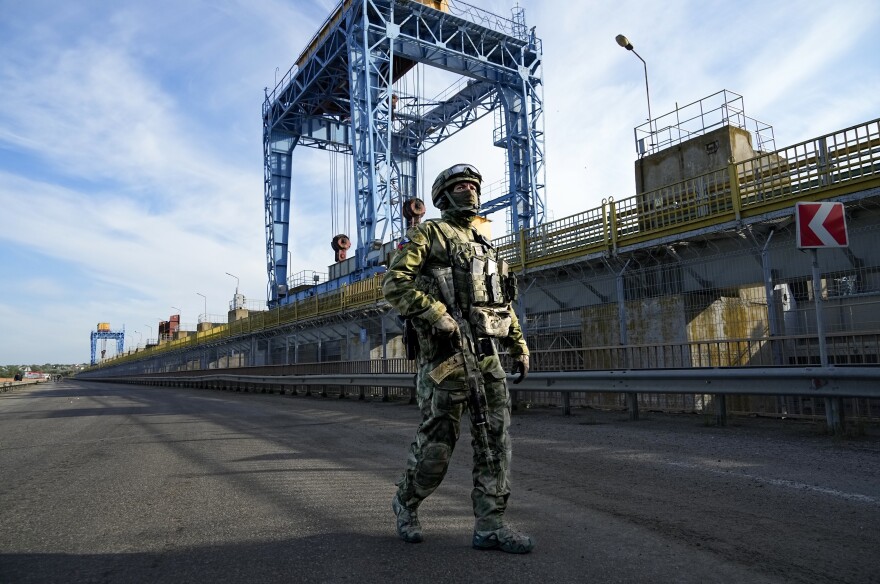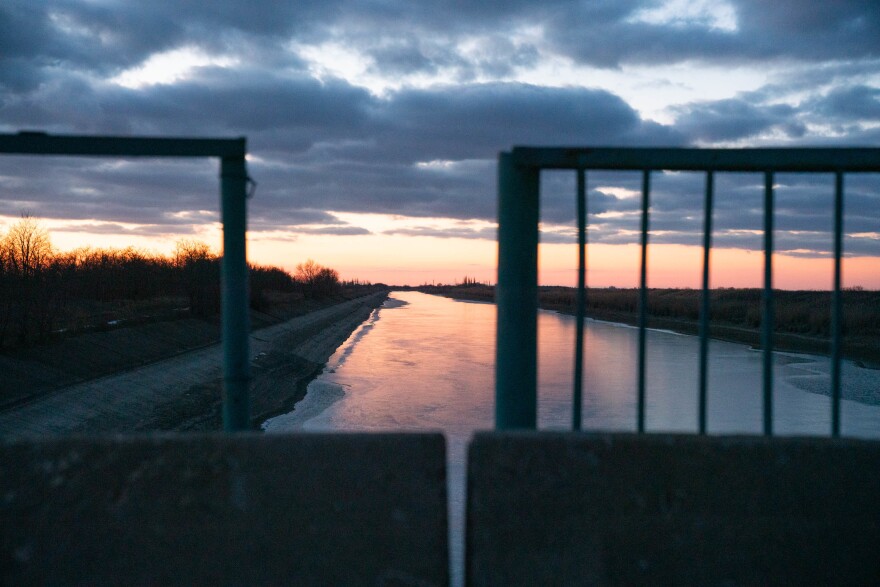Russia appears to be draining an enormous reservoir in Ukraine, imperiling drinking water, agricultural production and safety at Europe's largest nuclear plant, according to satellite data obtained by NPR.
Since early November 2022, water has been gushing out of the Kakhovka Reservoir, in Southern Ukraine, through sluice gates at a critical hydroelectric power plant controlled by Russian forces. As a result, satellite data shows that the water level at the reservoir has plummeted to its lowest point in three decades. Separate images provided by the commercial companies Planet and Maxar show water pouring through the gates, and shoreline along the giant reservoir emerging as a result of the rapidly falling water levels.
Loading...
At stake is drinking water for hundreds of thousands of residents, irrigation for nearly half-a-million acres of farmland, and the cooling system at the Zaporizhzhia Nuclear Power Plant. Late last week, the International Atomic Energy Agency said it was aware of the potential risk posed by dropping water levels at the reservoir.
"Even though the decreased water level does not pose an immediate threat to nuclear safety and security, it may become a source of concern if it is allowed to continue," the IAEA's director General Rafael M. Grossi said in a statement.
A major water source
The Kakhovka Reservoir is a massive, man-made lake roughly the size of the Great Salt Lake in Utah. It is the final body of water in a network of reservoirs along Ukraine's Dnipro River. Since the 1950s, it has been used to provide drinking and irrigation water to parts of Ukraine's southern districts of Kherson and Zaporizhzhia. A lengthy canal leading from the reservoir also supplies Russian-occupied Crimea.

The reservoir is essential to supplying water to otherwise arid farmland in the southern part of the country, according to Brian Kuns, a geographer at the Swedish University of Agricultural Sciences who has studied farming in southern Ukraine. A network of canals leading from the reservoir irrigates roughly 200,000 hectares (494,000 acres) of farmland that is used to grow sunflowers, grain and vegetables. "It's very important locally," Kuns says.
The reservoir was also a critical source of water for the Crimean Peninsula, which is supplied via a 403-kilometer (250 mile) canal. After Russia invaded Crimea in 2014, Ukraine diverted water from the canal, leaving the peninsula parched. Following Russia's larger invasion of Ukraine in February 2022, one of the goals was to restore Crimea's water supply, and Russia did so that summer by diverting water out of the reservoir.
Russia appeared to have spent several months using the Kakhovka Reservoir to refill a network of reservoirs in Crimea, according to David Helms, a retired meteorologist with decades of experience working for the U.S. federal government, most recently at the National Oceanographic and Atmospheric Administration. "There's 23 reservoirs; they're topped off," he says.
Opening the floodgates
Then on Nov. 11, 2022, as Ukrainian forces advanced, Russian troops blew up a road over the Kakhovka Hydroelectric Dam, which controls the water level on the reservoir.
Initially some feared that the explosion would damage the dam and spill water from the reservoir, but Helms says it seems to have destroyed the road, while leaving the dam's sluice gates mostly intact.
However immediately after the detonation, it appears that Russian forces deliberately used two gantry cranes on the Russian-controlled side of the dam to open additional sluice gates, allowing water to rush out of the reservoir.
The result has been startling. Radar altimetry data shows the current level of the reservoir at 14 meters, approximately 2 meters below its normal height. Since December, the reservoir's water level has plummeted to its lowest level in 30 years of satellite observation.
Loading...
A Feb. 7 statement on Telegram from the local government said that if the level fell below 13.2 meters, the Zaporizhzhia Nuclear Power Plant's cooling system, which relies on water from the reservoir, would be in peril. The statement said that Ukrhydroenergo, Ukraine's hydro electric company, believes the discharge is being done deliberately by the Russians.
The statement from the Zaporizhzhia Regional Military Administration also warned that several cities that rely on the reservoir, including Enerhodar, Melitopol and Berdyansk may face water shortages, though it noted that all three are currently under Russian occupation, so little is known about their water supply.
Unclear motivations
Helms believes the deliberate discharge is another way for Russia to hurt Ukraine. Now that Crimea's reservoirs are full, he says, this could be a way for Russia to hamper Ukraine's economy, which depends heavily on agricultural exports.
"It's as good as knocking out the power grid," he says.
But Kuns is less certain of Russia's intent. He points out that most of the affected agricultural areas are in Russian-held parts of Ukraine. "It just seems strange that they'd be doing a scorched-earth on territory that they claim publicly that they want to keep," he says.

In its statement, the Zaporizhzhia Regional Military Administration suggested that the purpose of draining the reservoir may be in part to flood the area south of the dam, in an effort to keep Ukrainian Forces from crossing the Dnipro River. Officials stated that Ukrhydroenergo believed Russian occupiers "opened the station's locks fearing an advance of Ukrainian soldiers."
For now, there's little to be done except watch the water as it drains away. "I don't know what the purpose of it is," says Kuns. "But it is very worrying."
With additional reporting by NPR's Sarah Knight, Brin Winterbottom. contributed to this story
Copyright 2023 NPR. To see more, visit https://www.npr.org.







